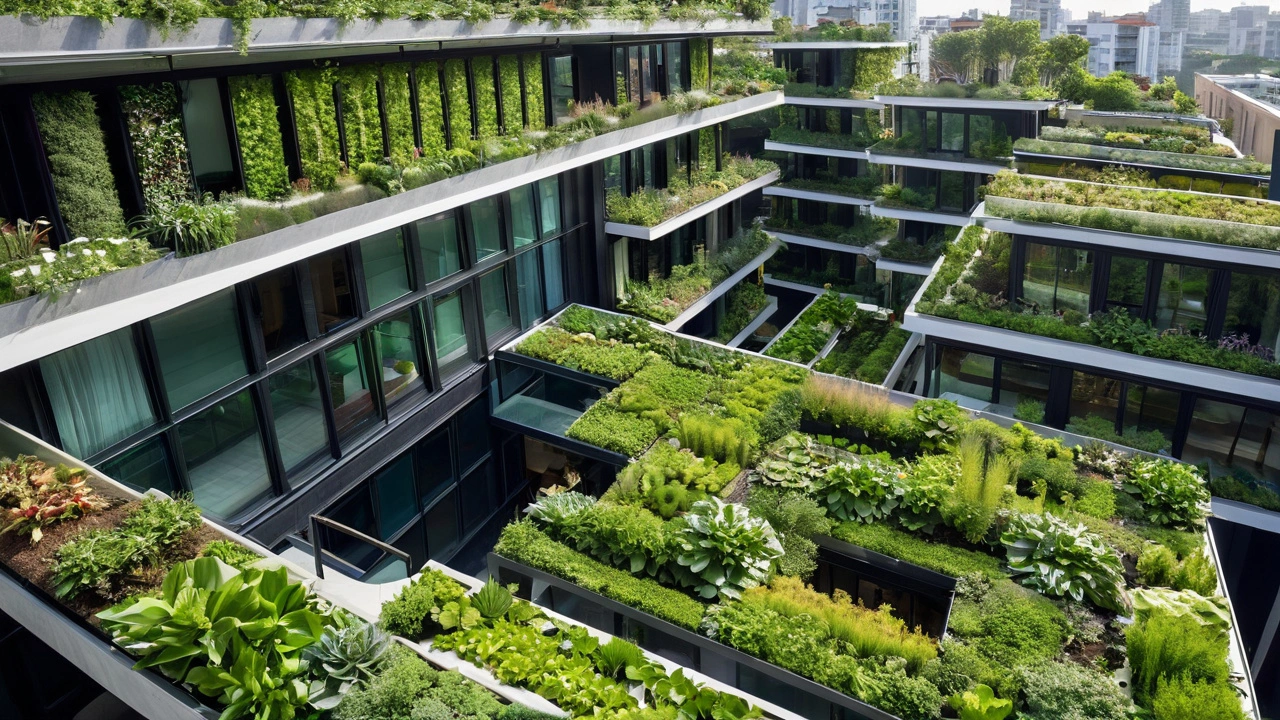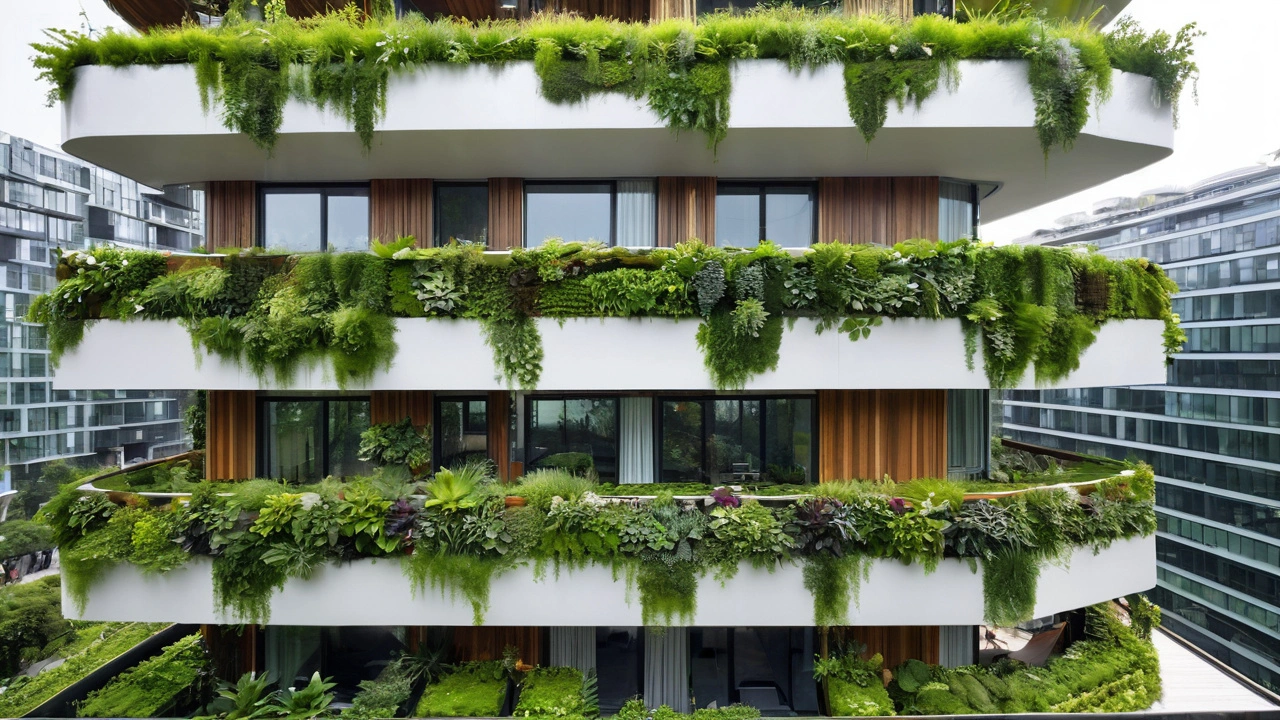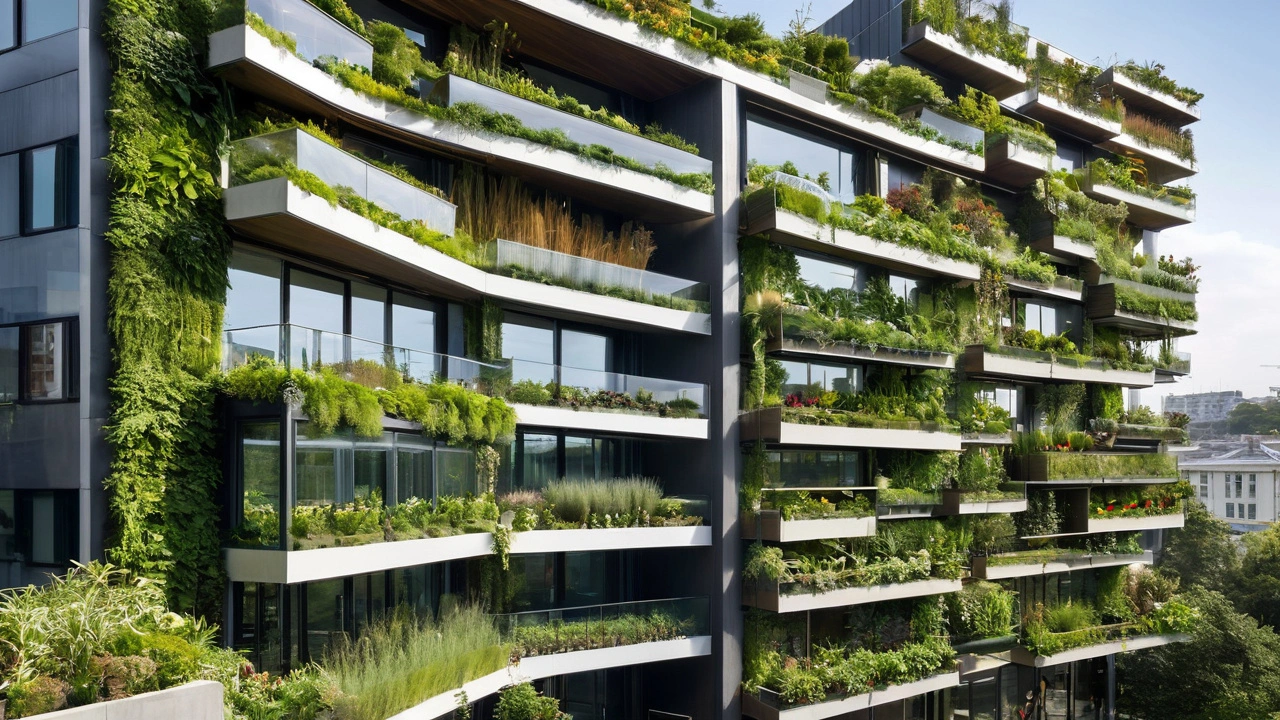The Rising Impact of Sustainable Architecture in Modern Times
 Jul, 27 2024
Jul, 27 2024
Sustainable architecture is revolutionizing the way we think about construction and design. By focusing on eco-friendly practices, it aims to reduce the environmental impact of buildings. This trend isn't just a fad; it's a vital shift towards a more sustainable future.
As we explore the innovations and benefits of sustainable architecture, you'll see how it's making a significant difference. From energy-efficient homes to large green skyscrapers, the move towards sustainability is evident across the globe.
Whether you're a homeowner, builder, or just someone interested in greener living, there are many ways to incorporate sustainable practices into your life. Let's dive into the world of sustainable architecture and discover the transformative power it holds.
- Introduction to Sustainable Architecture
- Innovations in Eco-friendly Design
- Benefits of Sustainable Buildings
- Notable Projects Around the World
- Tips for Incorporating Sustainability at Home
Introduction to Sustainable Architecture
The term sustainable architecture refers to building designs that promote environmental, economic, and social sustainability. The foundation of this concept dates back to ancient civilizations, but it wasn't until the late 20th century that it became a significant movement. Today, it is a crucial part of the architectural world, aiming to minimize the negative environmental impact of buildings through efficiency and moderation in the use of materials, energy, and development space.
A key principle of sustainable architecture is energy efficiency. Architects and builders use various techniques to reduce energy consumption, from passive solar design that optimally aligns buildings to the sun to advanced insulation materials that keep homes warm in the winter and cool in the summer. These methods help cut energy costs and reduce the carbon footprint of a building.
Another fundamental aspect is the use of sustainable materials. These materials are either recycled, renewable, or sourced in ways that do not deplete resources. Bamboo, for instance, is a favorite among sustainable builders because it grows quickly and has excellent structural properties. Similarly, recycled steel can be used instead of new steel, reducing the demand for energy-intensive steel production.
Water conservation is also a critical element of sustainable architecture. This can include everything from low-flow fixtures that reduce water use to rainwater harvesting systems that collect and utilize rainwater for landscaping and other non-potable uses. By reducing water consumption, buildings can lessen their impact on the local water supply and contribute to overall environmental sustainability.
Waste reduction is another important goal. During construction, a large amount of waste is generated. Sustainable architecture seeks to minimize this by recycling materials, designing modular buildings that can be easily deconstructed, and using construction methods that eliminate waste. For example, using prefabricated components can decrease on-site waste and improve efficiency.
"Architecture should speak of its time and place, but yearn for timelessness." - Frank Gehry
Green roofs and living walls are becoming increasingly popular in sustainable architecture. These not only provide insulation and help manage stormwater but also create habitats for wildlife and improve the quality of the air. In urban areas, where space is limited, these green spaces offer a much-needed respite from concrete and asphalt, contributing to the overall well-being of residents.
Technology also plays a significant role. Smart building systems that monitor and optimize energy use, water consumption, and even waste management are making it easier than ever to create truly sustainable buildings. These technologies can provide real-time data that helps building managers make informed decisions to maintain and improve sustainability over time.
Lastly, sustainable architecture often emphasizes the social aspect. This means creating buildings that promote the well-being of their occupants and the community. Natural lighting, good indoor air quality, and ergonomic designs that promote comfort and health are all examples of this approach. By focusing on the needs of the people who use buildings, sustainable architecture contributes to a more equitable and enjoyable built environment.
Innovations in Eco-friendly Design
Sustainable architecture is at the forefront of changing how we build and live. A key aspect of this transformation is the constant innovation in eco-friendly designs. These innovations are not just about using green materials; they focus on creating buildings and infrastructures that coexist harmoniously with the environment.
One notable innovation is the rise of green roofs and living walls. Green roofs are covered with vegetation, which helps in insulating buildings, reducing urban heat, and even absorbing rainwater. Living walls, on the other hand, are vertical gardens that can be found both inside and outside buildings, providing aesthetics and improving air quality. The Bosco Verticale in Milan, Italy is a prime example, with its high-rise buildings enveloped in lush greenery.
Another exciting innovation is the use of sustainable materials. These include bamboo, reclaimed wood, and recycled metal. Bamboo, for instance, is incredibly strong and grows much faster than traditional timber, making it a highly renewable resource. Reclaimed wood gives new life to old timber, reducing the need for new deforestation. Recycled metals are used in various construction components, lowering the carbon footprint significantly.
The advent of solar power technology has also revolutionized sustainable building designs. Photovoltaic panels are now being seamlessly integrated into the architecture itself. Not only can these solar panels generate electricity, but they can also serve as shingles, facades, and glass awnings, thus blending functionality with aesthetics. The Bullitt Center in Seattle is one of the most energy-efficient commercial buildings globally, thanks to its extensive solar arrays.
As noted by architect Norman Foster, "As an architect, you design for the present with an awareness of the past for a future which is essentially unknown." This quote captures the essence of how sustainable designs cater to the current needs while preparing for an uncertain future.
Water conservation technologies also play a crucial role in sustainable architecture. Systems for rainwater harvesting and gray water recycling are becoming standard practices in eco-friendly buildings. Such systems not only save water but also reduce strain on public water supplies. For instance, the Phipps Conservatory and Botanical Gardens' Center for Sustainable Landscapes in Pittsburgh utilizes an advanced water management system that processes stormwater and wastewater on-site.
Additionally, energy management systems are making buildings smarter and more efficient. These systems use sensors and automation to optimize energy use based on real-time conditions. Building Information Modeling (BIM) software helps architects and engineers visualize and plan the most efficient way to use resources. The Edge building in Amsterdam is known for its smart systems which include sensors that monitor everything from lighting to workspace occupancy, ensuring minimal energy wastage.
Finally, there's innovation in passive design strategies. These strategies use the building's site and orientation to maximize natural light and ventilation, reducing the need for artificial lighting and air conditioning. Designs that incorporate large windows, skylights, and open floor plans help in achieving this. The Treehouse, a residential building in Singapore, uses passive design successfully to maintain a comfortable indoor environment with minimal mechanical intervention.
These innovations in eco-friendly design are more than just trends; they are essential advancements that address pressing environmental concerns. By embracing these techniques and materials, we can look forward to a future where our built environments contribute positively to the planet. The transition towards sustainable architecture is not only beneficial but necessary for ensuring a healthy and resilient future.

Benefits of Sustainable Buildings
The movement towards sustainable architecture has brought about not only a boon for the environment but also for the people who inhabit these spaces. The benefits of sustainable buildings are numerous and profoundly impactful, making them indispensable for a greener future. One key advantage is their reduced environmental footprint. By utilizing renewable energy sources such as solar and wind power, these buildings significantly cut down their carbon emissions, helping to fight climate change.
Another significant benefit is the cost savings over time. While the initial investment in sustainable technology might be higher, the energy efficiency achieved leads to lower utility bills. For instance, LED lighting, energy-efficient HVAC systems, and superior insulation are just a few features that contribute to these savings. According to the U.S. Green Building Council, green buildings can result in savings of nearly 30% in energy usage.
Notably, sustainable buildings also promote healthier living environments. These structures ensure better indoor air quality by using non-toxic materials and improving ventilation systems. This can lead to fewer respiratory problems and a general increase in occupants' well-being. A well-known study by the Harvard T.H. Chan School of Public Health found that people in green buildings showed a 61% increase in cognitive function.
Community impact cannot be overlooked either. Sustainable buildings often incorporate thoughtful designs that foster a sense of community. Green roofs, community gardens, and shared spaces encourage social interaction and connection among residents. This not only improves mental health but also builds stronger, more resilient communities.
Moreover, these buildings often showcase innovative design and technology, pushing the boundaries of modern architecture. They set new benchmarks for efficiency and aesthetics that influence future building projects. From smart water management systems to rainwater harvesting, these innovations prove that sustainability and style can go hand in hand.
Sustainable architecture also plays a vital role in resource conservation. By using recycled and locally sourced materials, builders reduce waste and support local economies. Bamboo, reclaimed wood, and recycled metal are just some examples of materials that can be used sustainably. This reduces the strain on natural resources and minimizes the environmental impact of new construction.
Additionally, sustainable buildings can increase property values. As awareness of the environmental crisis grows, more people are willing to invest in eco-friendly homes. Certified green buildings are selling faster and often at higher prices compared to conventional buildings. This makes them not only an ethical choice but also a sound financial investment.
Lastly, it's worth noting the contribution to regulators and policymakers advocating for sustainable practices. These buildings often surpass the minimum requirements and become models for future regulations. They provide real-world data and case studies that policymakers use to form better, more sustainable building codes and practices. Architect William McDonough stated, "Design is the first signal of human intentions." Sustainable architecture aligns with these intentions to create a better, more sustainable world for future generations.
Notable Projects Around the World
When it comes to sustainable architecture, a few standout projects have set the benchmark for what is possible. These buildings not only embody the principles of eco-friendly construction but also showcase innovative designs that inspire future developments. One prime example is the Bosco Verticale in Milan, Italy. This pair of residential towers integrates trees and shrubs right into the building itself, creating a striking green façade. The design serves multiple purposes, such as improving air quality, reducing noise pollution, and enhancing the well-being of residents.
Another remarkable project is the Bullitt Center in Seattle, often heralded as the greenest commercial building in the world. This six-story office structure is entirely self-sufficient, generating its own electricity through solar panels and collecting rainwater for all its water needs. It's a living testament to what sustainable architecture can achieve, combining advanced technology with mindful design principles. Denis Hayes, President of the Bullitt Foundation, once said,
"The Bullitt Center shows what's possible when we aim for the highest bar. It's not just about sustainability; it's about creating a healthier environment for everyone."
Meanwhile, in Singapore, the Parkroyal Collection Pickering Hotel stands as a shining example of urban sustainability. Its design features sky gardens, waterfalls, and planter terraces, all contributing to a lush, green environment right in the heart of the city. The hotel's energy-saving features, such as its rainwater harvesting system and efficient lighting, make it a model for future urban developments. These initiatives not only reduce the building's carbon footprint but also offer guests a unique, nature-infused experience in an urban setting.
Other inspiring examples include the Edge in Amsterdam, known as the world's smartest building. This state-of-the-art office complex uses advanced technology to optimize energy use, from its nearly 30,000 sensors that monitor light, temperature, and humidity, to its rooftop solar panels. With these features, the Edge has achieved a 98.36% score in sustainability from BREEAM, making it a global leader in energy-efficient office spaces. The data-driven approach taken by the designers helps seamlessly integrate sustainability into everyday operations, setting a precedent for future smart buildings.
Finally, consider the One Central Park in Sydney, Australia. This mixed-use building complex features a unique heliostat that redirects sunlight into shaded areas, ensuring natural light reaches every corner. Its vertical gardens, designed by renowned botanist Patrick Blanc, host a variety of plant species, creating a visually stunning and environmentally beneficial facade. The building's water recycling and energy-efficient systems further solidify its status as a pioneer in sustainable urban design.
Together, these projects highlight how sustainable architecture is not just an idealistic goal but a practical and achievable reality. By learning from these examples, future constructions can continue to push the boundaries of what is possible, leading the way to a greener and more sustainable world.

Tips for Incorporating Sustainability at Home
Embracing sustainable practices at home is a rewarding way to contribute to environmental conservation while also enhancing your quality of life. One of the most impactful changes you can make is improving the energy efficiency of your home. Start with simple steps like replacing incandescent bulbs with LED lights. They use about 75% less energy and last up to 25 times longer.
Another effective strategy is to invest in a programmable thermostat. These devices can significantly lower your energy consumption by adjusting the temperature based on your daily schedule. According to the U.S. Department of Energy, you can save up to 10% a year on heating and cooling by simply turning your thermostat back 7°-10°F for 8 hours a day from its normal setting.
Water conservation is another key aspect of sustainable living. Installing low-flow faucets and showerheads can reduce water usage without sacrificing performance. Additionally, fixing any leaks promptly can save thousands of gallons of water annually. Collecting rainwater for irrigation purposes is also a great way to recycle natural resources.
Building materials play a crucial role in home sustainability. Opt for replenishable materials such as bamboo, cork, or reclaimed wood. These materials not only reduce waste but also add unique aesthetic elements to your home. Using non-toxic paints and finishes can also improve indoor air quality, making your home healthier.
Renewable energy options like solar panels can drastically cut down on your electricity bills and reduce your carbon footprint. Although the initial investment might be high, the long-term benefits are substantial. Many governments offer tax incentives and rebates that can offset installation costs. A study by the National Renewable Energy Laboratory (NREL) found that homes with solar panels sell 20% faster and for 17% more money than those without.
Smart home technology can aid your sustainability efforts as well. Devices such as smart plugs and energy-efficient appliances allow you to monitor and manage your energy usage in real-time. By automating lighting, heating, and cooling systems, you can ensure they run only when needed, thus avoiding wastage.
Landscaping is another area where you can incorporate sustainable practices. Planting native species in your garden requires less water and maintenance. Creating a compost bin for organic waste not only enriches your soil but also reduces the amount of waste sent to landfills. Incorporating edible plants can provide fresh produce, reducing your reliance on store-bought goods.
Moreover, adopting a minimalist lifestyle can have a surprisingly positive impact on sustainability. By reducing your consumption and focusing on high-quality, long-lasting items, you decrease waste and the demand for resource-intensive production. This approach also promotes a clutter-free, organized living space, making your home more pleasant and efficient.
Lastly, joining community initiatives can amplify your efforts. Many neighborhoods now have sustainability groups focused on sharing resources, organizing clean-ups, and promoting eco-friendly practices. Participating in these groups can provide support and further motivation to keep up sustainable habits.
"Sustainability is not just about doing something good for the environment. It's about creating a healthier, more cost-effective way of living that benefits everyone," says Jane Goodall, renowned primatologist and environmentalist.
Incorporating these tips doesn't require a drastic lifestyle change. Small, consistent efforts can add up to make a significant impact. By making these adjustments, you'll contribute to a healthier planet while enjoying the personal benefits of a sustainable home.